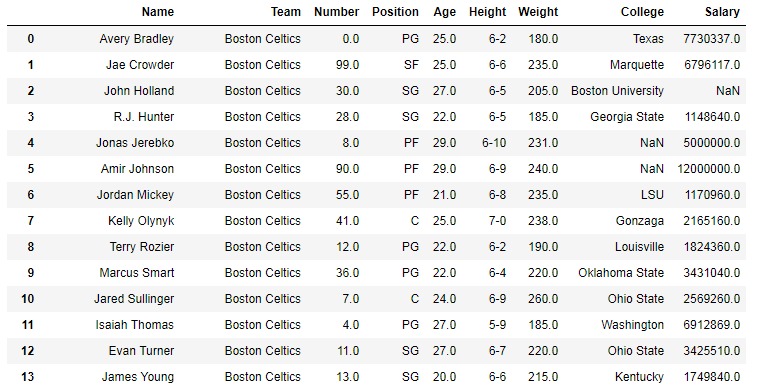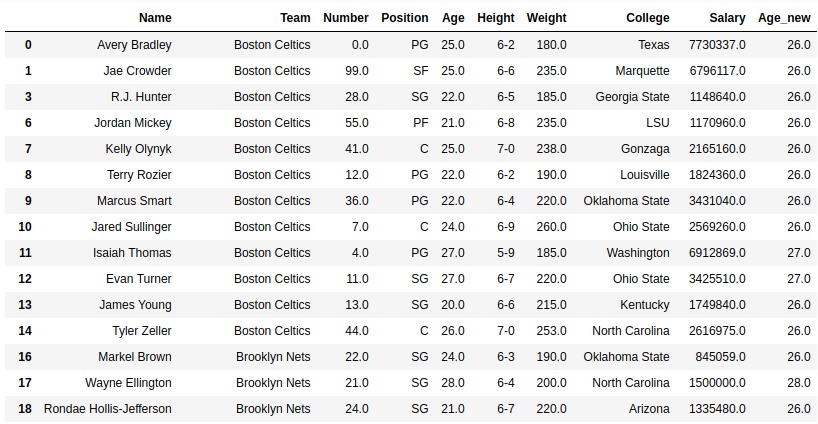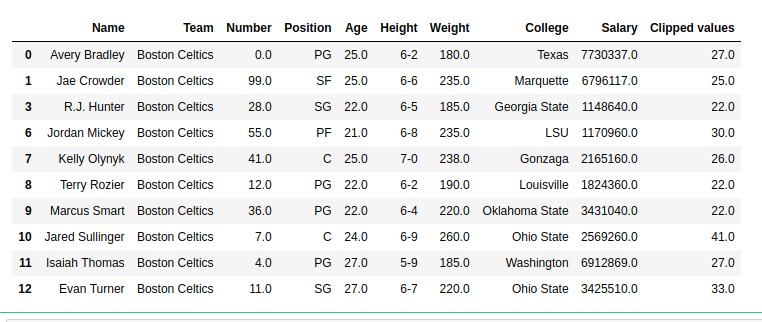Python是進行數據分析的一種出色語言,主要是因為以數據為中心的Python軟件包具有奇妙的生態係統。 Pandas是其中的一種,使導入和分析數據更加容易。
Pandas Series.clip_lower()用於將值裁剪為低於傳遞的最小值。閾值作為參數傳遞,並且所有小於閾值的串聯值都等於該閾值。
用法:Series.clip_lower(threshold, axis=None, inplace=False)
參數:
threshold:數字或類似列表,設置最小閾值,如果是列表,則為調用者係列中的每個值設置單獨的閾值(給定列表大小相同)
axis:0或“索引”按行應用方法,1或“列”按列應用
inplace:在調用者係列本身中進行更改。 (用新值覆蓋)
返回類型:具有更新值的係列
要下載以下示例中使用的數據集,請單擊此處。
在以下示例中,使用的 DataFrame 包含一些NBA球員的數據。下麵是任何操作之前的數據幀圖像。

例子1:適用於單值係列
在此示例中,最小閾值26作為參數傳遞給.clip_lower()方法。在數據幀的Age列上調用此方法,並將新值存儲在Age_new列中。在執行任何操作之前,使用.dropna()刪除空行
# importing pandas module
import pandas as pd
# making data frame
data = pd.read_csv("https://media.geeksforgeeks.org/wp-content/uploads/nba.csv")
# removing null values to avoid errors
data.dropna(inplace = True)
# setting threshold value
threshold = 26.0
# applying method and passing to new column
data["Age_new"]= data["Age"].clip_lower(threshold)
# display
data輸出:
如輸出圖像中所示,Age_new列的最小值為26。所有小於26的值都增加到26,並存儲在新列中。

範例2:應用於具有列表類型值的係列
在此示例中,使用.head()方法提取並存儲了年齡列的前10行。之後,將創建一個長度相同的列表,並將其傳遞到.clip_lower()方法的閾值參數,以為每個串聯的值設置單獨的閾值。返回的值存儲在新列“ clipped_values”中。
# importing pandas module
import pandas as pd
# importing regex module
import re
# making data frame
data = pd.read_csv("https://media.geeksforgeeks.org/wp-content/uploads/nba.csv")
# removing null values to avoid errors
data.dropna(inplace = True)
# returning top rows
new_data = data.head(10).copy()
# list for separate threshold values
threshold =[27, 23, 19, 30, 26, 22, 22, 41, 11, 33]
# applying method and returning to new column
new_data["Clipped values"]= new_data["Age"].clip_lower(threshold = threshold)
# display
new_data輸出:
如輸出圖像所示,根據傳遞的列表,每個串聯的值都有不同的閾值,因此,根據每個元素的單獨閾值返回結果。

相關用法
- Python pandas.map()用法及代碼示例
- Python Pandas Series.str.len()用法及代碼示例
- Python Pandas.factorize()用法及代碼示例
- Python Pandas TimedeltaIndex.name用法及代碼示例
- Python Pandas dataframe.ne()用法及代碼示例
- Python Pandas Series.between()用法及代碼示例
- Python Pandas DataFrame.where()用法及代碼示例
- Python Pandas Series.add()用法及代碼示例
- Python Pandas.pivot_table()用法及代碼示例
- Python Pandas Series.mod()用法及代碼示例
- Python Pandas Dataframe.at[ ]用法及代碼示例
- Python Pandas Dataframe.iat[ ]用法及代碼示例
- Python Pandas.pivot()用法及代碼示例
- Python Pandas dataframe.mul()用法及代碼示例
- Python Pandas.melt()用法及代碼示例
注:本文由純淨天空篩選整理自Kartikaybhutani大神的英文原創作品 Python | Pandas Series.clip_lower()。非經特殊聲明,原始代碼版權歸原作者所有,本譯文未經允許或授權,請勿轉載或複製。
